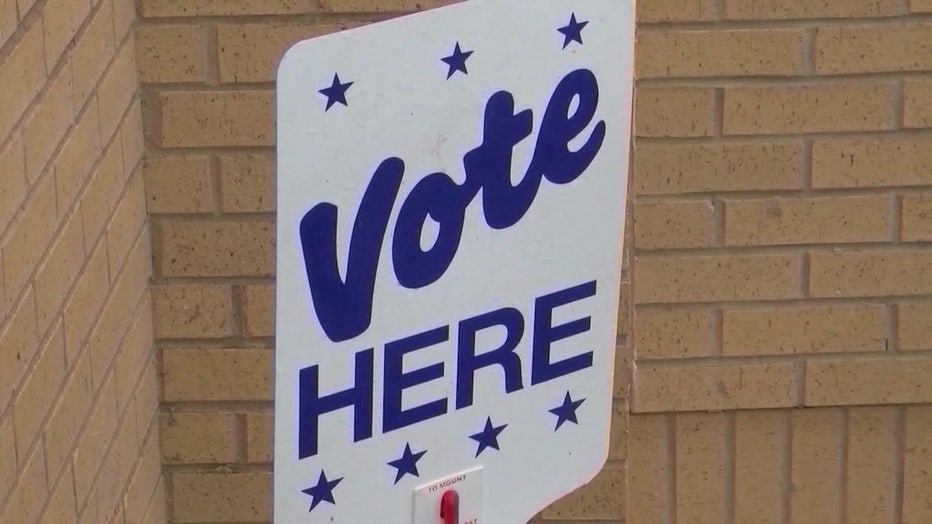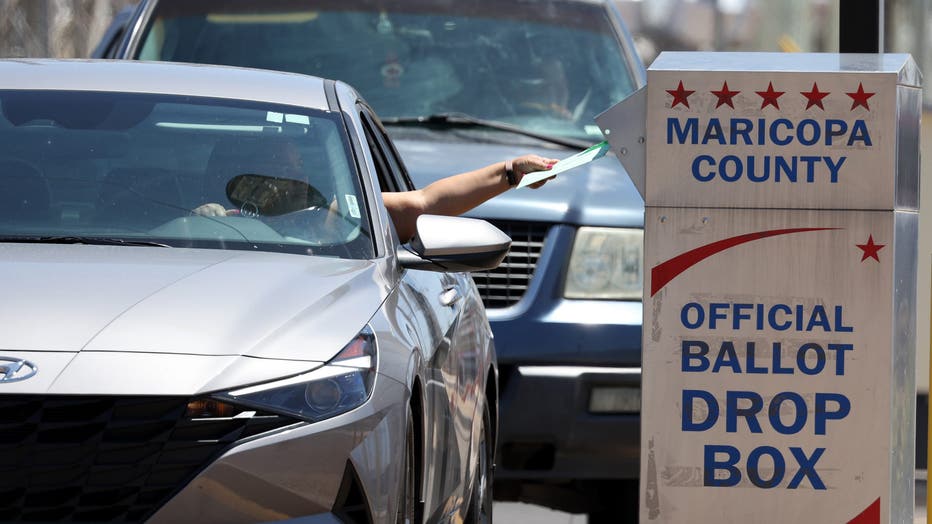Proposition 140: What you should know about the Make Elections Fair Arizona Act
Arizona voter registration deadline is Oct. 7
The general election is less than a month away and if you still need to register to vote, you only have hours to do so. Arizona's voter registration deadline is at 11:59 p.m. on Oct. 7.
PHOENIX - A measure on the November ballot in Arizona aims to change the way elections are conducted in the Grand Canyon State.
Here's what to know about Arizona's Proposition 140, the impact it could have on Arizona elections, and why people are for or against the ballot measure.
What's Proposition 140?
Like all propositions with a number that begins with a "1," Proposition 140 is a measure that aims to amend the Arizona State Constitution.
Per the General Election Publicity Pamphlet that was published by the Arizona Secretary of State's Office, the measure will, if approved by voters, change the way primary and general elections are conducted in Arizona.
Primary Election
Under the measure, all qualified candidates for an elected office will be placed on the same primary ballot, regardless of their political affiliation, and all qualified voters may vote in the primary, regardless of their political party affiliation.
Candidates gathering signatures to qualify for the ballots can also gather from any qualified voters, regardless of political affiliations, and the signature requirements will be the same for all candidates.
Following a primary election, the number of candidates who can advance to the general election will differ, depending on how many seats are up for election for a particular office, without regard to political party affiliations or a lack thereof:
- One seat: No less than two and no more than five
- Two seats: No less than four and no more than seven
- Three seats: No less than six and no more than eight
The measure also states if state lawmakers do not pass a law to determine the actual number of candidates who will advance to the general election that takes effect on or before Nov. 1, 2025, the Secretary of State will determine the number of candidates for each office who will advance to the general election, consistent with the rules set forth in the ballot measure.
General Election
The manner in which a general election is conducted will differ, based on how many candidates there are.
- One-seat race with only two candidates: The candidate who gets the majority of votes cast wins the seat
- One-seat race with three or more candidates: Voter ranking will be used to determine the winner
"This process, at a minimum, shall allow a voter to rank all candidates for an office in order of the voter's preference," read a portion of the ballot measure with regards to voter ranking.
If approved by voters, the measure will take effect for elections that take place after July 1, 2026.
How do elections work in Arizona?

Currently, candidates are placed on separate political party ballots in Arizona's primary elections. This means a Republican Party primary ballot will only have candidates who are affiliated with the GOP, and the same goes for Democratic Party candidates.
The Arizona State Government currently recognizes five political parties: Democratic, Green, Libertarian, No Labels, and Republican. Due to a January 2024 court ruling, however, the Secretary of State's Office is banned from accepting No Labels candidate filings for the primary or general elections, aside from the party's presidential and vice presidential nominees. The party abandoned its quest for a presidential bid in 2024.
As for the general election, all candidates for a political office are on one ballot, and the person who receives the most votes will win the election.
What is RCV (ranked choice voting)?
Voter ranking, as described in the ballot measure, is similar to the description for what is known as "ranked choice voting," or RCV.
According to fairvote.org, ranked choice voting, also known as instant runoff voting, gives voters the option of ranking the candidates in the order of a voter's preference.
The Ranked Choice Voting Resource Center offers a more detailed description of how ranked choice voting works: in a race with one winner, voters will rank their choice of candidates, and in the first round of counting, the voters' first choices are counted.
If a candidate receives more than half of the first choices made, that candidate will win the race.
"If there is no majority winner after counting the first choices, the race continues to another round of counting," read a portion of the description. "The candidate with the fewest votes is eliminated, and voters who ranked that candidate as their first choice will have their votes transferred to their next choice. This process continues until a candidate receives a majority of the votes in a round of counting."
Is Ranked Choice Voting used in the U.S.?
The Ranked Choice Voting Center states that RCV is used 62 U.S. jurisdictions, including Alaska, Maine, and a number of cities.
In the case of Alaska, voters there approved a ballot measure in 2020 to establish RCV for the general election. It was first used in a special election in August 2022, and the state currently uses RCV for all federal races, as well as for gubernatorial and state legislative elections.
As for Maine, the state first used RCV in their 2018 primary election. Per the AP, voters there approved an RCV voting system in 2016.
What are the advantages and disadvantages of Ranked Choice Voting?
Advantages
An article published by the Leage of Women Voters in Vermont claims that the final winner in an election with RCV has the support of the majority of voters, as the vote continues until one candidate has a majority of the votes cast.
Meanwhile, a 2023 article published by the Council of State Governments claims that RCV could encourage more civility in campaigns.
"In ranked voting elections, candidates have an incentive to court as many voters as possible in hopes of winning. If they are not the first choice of voters, they can succeed by acquiring enough votes as the second or third choices. This can lessen the tendency to run negative campaigns involving attacks on opponents and instead encourage efforts to positively interact with as many voters as possible, even those who may not view them as a first choice," a portion of the article reads.
Disadvantages
An article published by a group called Institute for Responsive Government states that RCV could have consequences for candidates of color and minority representation in a state.
"RCV may ultimately hurt candidates of color by undermining traditional paths to power for candidates of color in state and federal contests," read a portion of the article.
The article also states that RCV can increase voter error, citing a study that incorporates data from Alaska and Maine.
"These errors can include overvotes (where a voter selects more than one candidate for a given ranking), overranking (where a voter ranks the same candidate more than once), and skips (where a voter leaves a ranking blank but fills in a subsequent ranking)," a portion of the article reads. "Other studies similarly find that ballot errors in RCV elections are particularly high in areas with lower levels of education, lower levels of income, higher minority populations, and a higher share of limited English proficient voters."
Election officials in Alaska have listed a number of mistakes that voters could make with RCV ballots, including overvoting, overranking, and skipping, and how they deal with such mistakes when the vote is counted. The same website also teaches voters how to properly vote on an RCV ballot.
What is the impact of Proposition 140?

A voter places a ballot in a drop box outside of the Maricopa County Elections Department. (Photo by Justin Sullivan/Getty Images)
Per a fiscal analysis made by the Joint Legislative Budget Committee, the measure could affect the cost of holding elections due to:
- An increase in the number of people who appear on the general election ballot
- A change in the length of both sample and election ballots
- An increase in the number of voters who receive a primary ballot
What are supporters saying about Proposition 140?
In the publicity pamphlet published by the Arizona Secretary of State's Office, supporters claim Arizona's current electoral system marginalizes independent and unaffiliated voters, in a state where such voters form a sizable bloc.
"The Make Elections Fair Initiative ends discrimination against voters and candidates based on party affiliation. It reduces the pernicious effects of gerrymandering, which currently enable politicians to run unopposed or have such a significant partisan advantage that they are virtually guaranteed a seat after winning only the primary, which reduces voters choices and promotes divisiveness," reads a statement that is jointly written by the Chairperson and Co-Chairs of the Make Elections Fair Arizona campaign.
One supporter of the measure states the current electoral system favors "extreme voices within the parties," and "discourages moderate points of view."
"This is a common-sense solution that will moderate the partisanship that’s been stifling progress on policy issues like school funding, voucher accountability, abortion care, affordable housing, water and environmental policy, and other important issues," wrote Arizona Public Health Association Executive Director Will Humble.
What are opponents saying about Proposition 140?
Some opponents say the measure will confuse voters, make ballots longer, and delay vote-counting results.
"Jungle Primaries and Ranked Choice Voting have been tried in California already. Since its adoption it has led to candidates from only one political party appearing on the general election ballot, depriving many voters of any choice at all," wrote Arizona Free Enterprise Club President Scot Mussi.
One opponent questions whether results for elections with RCV can accurately reflect voter preferences.
"With the possibility of numerous candidates and complex vote transfers, the winner may not necessarily be the most preferred candidate overall, but rather the one deemed least objectionable by the majority. This undermines the principle of majority rule and can lead to outcomes that lack legitimacy in the eyes of voters," Kristan Culbertson of Parks, Ariz. wrote.
Is there another ballot measure this year that is related to elections?
Another ballot measure on this November's election, named Proposition 133, also aims to make changes to the state's electoral system.
If approved by voters, the measure will:
- Require that direct primaries for any political office allow each political party that has qualified for the ballot to "nominate the same number of candidates for the office as the number of positions to be filled for that office in the next general election."
- Require that each eligible candidate "who is nominated by a political party that has qualified for representation on the ballot in a direct primary election be placed on the official ballot for the next general election."

